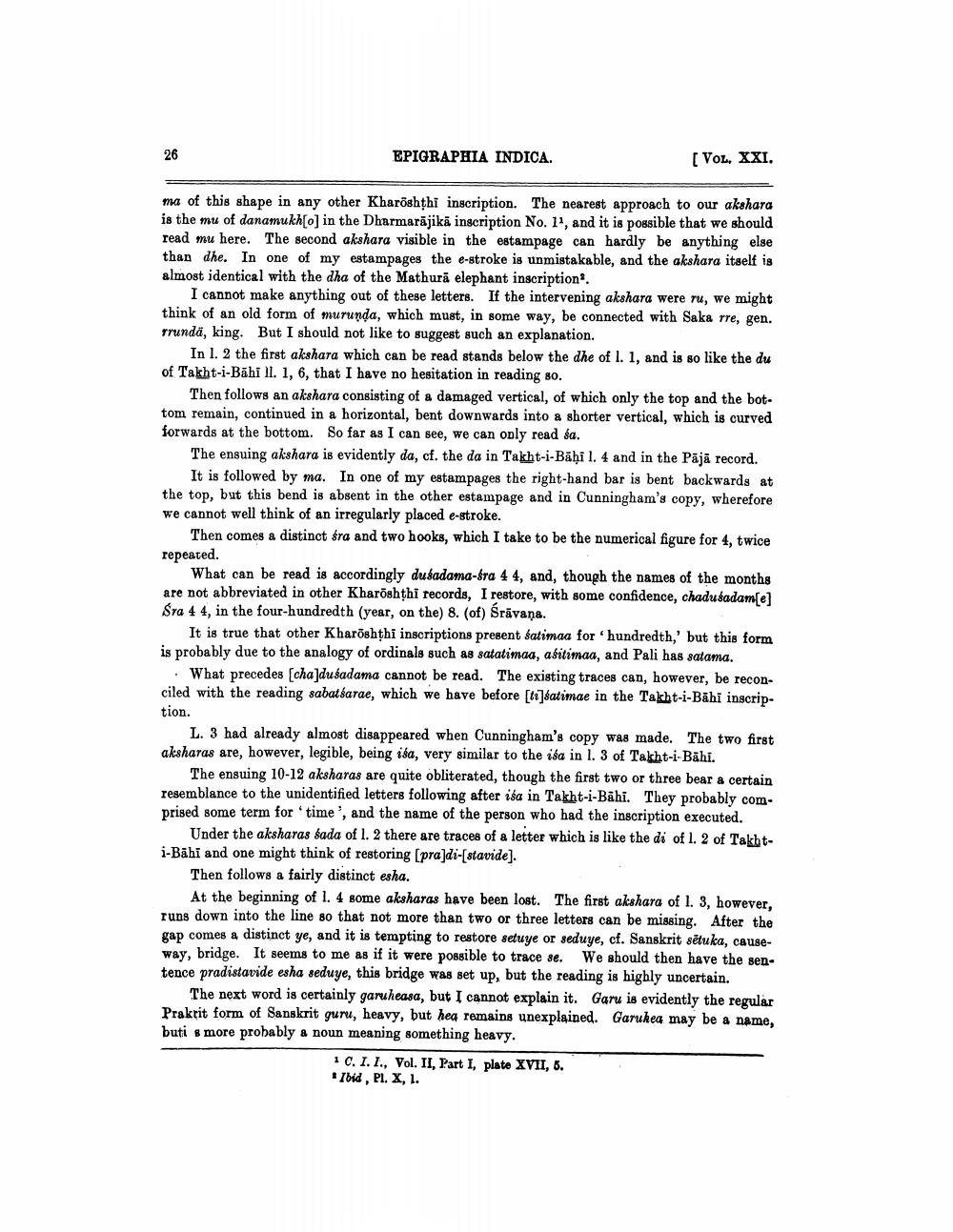________________
EPIGRAPHIA INDICA.
(VOL. XXI.
ma of this shape in any other Kharöshthi inscription. The nearest approach to our akshara is the mu of danamukh[o] in the Dharmarājikā inscription No. 14, and it is possible that we should read mu here. The second akshara visible in the estampage can hardly be anything else than dhe. In one of my estampages the e-stroke is unmistakable, and the akshara itself is almost identical with the dha of the Mathurā elephant inscription.
I cannot make anything out of these letters. If the intervening akshara were ru, we might think of an old form of murunda, which must, in some way, be connected with Saka tre, gen. rrundä, king. But I should not like to suggest such an explanation.
In l. 2 the first akshara which can be read stands below the dhe of l. 1, and is so like the du of Takht-i-Bāhi II. 1, 6, that I have no hesitation in reading so.
Then follows an akshara consisting of a damaged vertical, of which only the top and the bottom remain, continued in a horizontal, bent downwards into a shorter vertical, which is curved forwards at the bottom. So far as I can see, we can only read ta.
The ensuing akshara is evidently da, cf. the da in Takht-i-Bāhi l. 4 and in the Pājā record.
It is followed by ma. In one of my estampages the right-hand bar is bent backwards at the top, but this bend is absent in the other estampage and in Cunningham's copy, wherefore we cannot well think of an irregularly placed e-stroke.
Then comes a distinct fra and two hooks, which I take to be the numerical figure for 4, twice repeated.
What can be read is accordingly dusadama-śra 4 4, and, though the names of the months are not abbreviated in other Kharöshthi records, I restore, with some confidence, chadušadam[e] Sra 4 4, in the four-hundredth (year, on the) 8. (of) Srāvana.
It is true that other Kharoshthi inscriptions present satimaa for hundredth,' but this form is probably due to the analogy of ordinals such as satatimaa, afitimaa, and Pali has satama.
What precedes (cha)dusadama cannot be read. The existing traces can, however, be reconciled with the reading sabatsarae, which we have before [t]satimae in the Takht-i-Bāhi inscription.
L. 3 had already almost disappeared when Cunningham's copy was made. The two first aksharas are, however, legible, being isa, very similar to the isa in l. 3 of Takht-i-Bāhi.
The ensuing 10-12 aksharas are quite obliterated, though the first two or three bear a certain resemblance to the unidentified letters following after isa in Takht-i-Bāhi. They probably comprised some term for time, and the name of the person who had the inscription executed.
Under the aksharas sada of 1.2 there are traces of a letter which is like the di ofl. 2 of Takhti-Bāhi and one might think of restoring (praldi-[stavide].
Then follows a fairly distinct esha.
At the beginning of l. 4 some aksharas have been lost. The first akshara of l. 3, however, runs down into the line so that not more than two or three letters can be missing. After the gap comes a distinct ye, and it is tempting to restore setuye or seduye, cf. Sanskrit sētuka, causeway, bridge. It seems to me as if it were possible to trace se. We should then have the sentence pradistavide esha seduye, this bridge was set up, but the reading is highly uncertain.
The next word is certainly garuheasa, but I cannot explain it. Garu is evidently the regular Prakrit form of Sanskrit guru, heavy, but he remains unexplained. Garukea may be a name, buti s more probably a noun meaning something heavy.
* C.I.I., Vol. II, Part I, plate XVII, 6. * Ibid, Pl. X, L.




